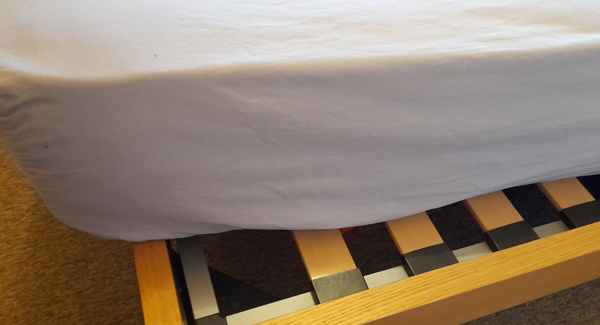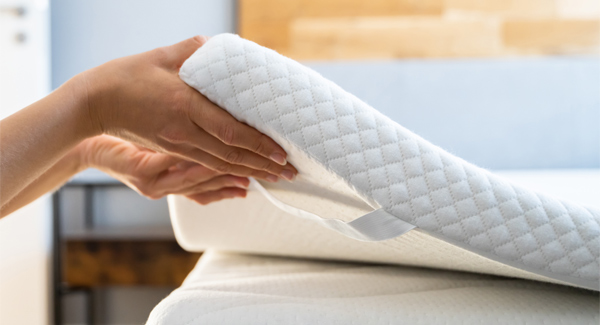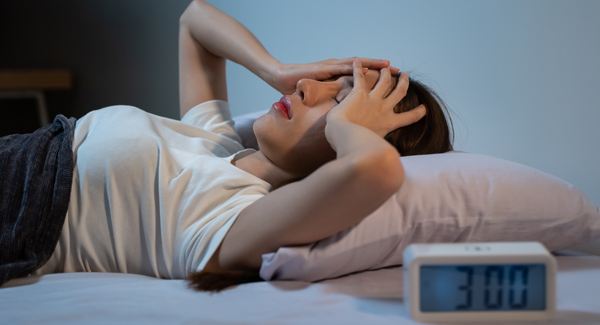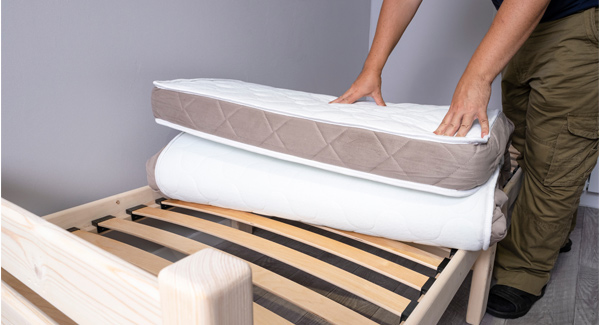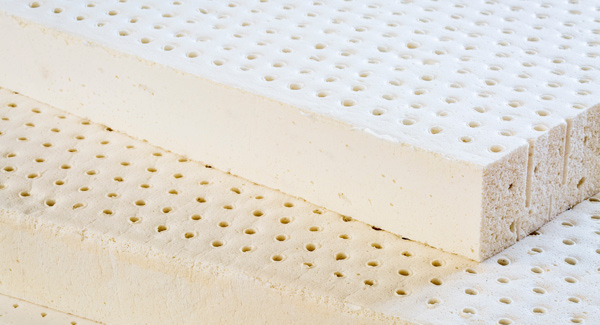Home » Mattress advice » How To Keep A Mattress From Sliding
How to keep a mattress from sliding
Article navigation
- Published:
- Written by: Tony Brown
- Topic: Mattress advice
Your bedroom is a place for rest and relaxation, but there’s nothing more frustrating than a mattress that slides around every time you get in and out of bed.
This article looks at the reasons why your mattress might be sliding out of place and looks at ways you can prevent it from happening.
Why does my mattress move around?
There are several reasons why your mattress might be moving around. But a closer inspection of your bed should identify the root cause of the problem.
Little or no friction
Mattress sliding is usually caused by a lack of friction between the mattress and the bed base it sits on. One of the main reasons for this is there is no grip from the material on either the mattress or the bed base.
The bed frame is bigger than the mattress
When a mattress is paired with a bed frame, there is usually a small gap between the outer frame and the mattress that sits inside it. This is usually no cause for concern. But in some cases, where there is a wider gap, this can cause the mattress to move around.
A wider gap can be particularly noticeable with newer mattresses. Because of the way some mattresses are transported, this may cause them to contract slightly during transit. So when the mattress sits on the bed frame, it can appear smaller than expected. This gap may cause some movement initially, but the new mattress should return to its normal size after use. This may help to ease the problem.
The style of the bed frame
Some mattresses sit on top of the bed frame rather than inside it. As the mattress is not fenced in, this can cause some extra movement.
Depending on the style, some bed frames may not have side rails or even a footboard.. This is common with metal bed frames and slatted ottoman beds.
The weight of the mattress
The weight of a mattress can be indicative of its quality. A higher-quality mattress will contain vast amounts of materials. It will be much heavier and less likely to slide and move around.
While a cheaper mattress is likely to contain fewer springs and materials, so will be much lighter and is more likely to slide and move around.
The size of the mattress will also make a difference in its weight. Single-sized mattresses are more likely to move around than bigger sizes.
Your mattress is past its best
An old, unsupportive mattress can be a sign that your mattress is past its best and can contribute to restless sleep. As a result, increased tossing and turning during the night can cause your mattress to move around.
How to stop a mattress from sliding
Having identified why your mattress might be sliding, here are a few tips and solutions that may prevent it from happening.
Use a mattress pad
If your mattress rests on a slatted bed frame, you could place a mattress pad underneath it to protect it from splinters and indentations from the slats. A mattress pad can also help grip your mattress and stop it from sliding and slipping around on the bed base. You can also use a clean, breathable blanket instead.
Mattress grippers
Another option is to use mattress grippers. These are essentially slip-resistant material pads that you place between your mattress and its bed base to help prevent your mattress from sliding.
The pads can usually be cut down to size so that they are not visible when the mattress rests on top of the bed base.
Change your bed
Movement in your mattress can be caused by either the mattress itself, the bed base it sits on or a combination of the two. If your bed is several years old, you should be replacing the mattress and the bed base at the same time.
But, if you decide to change one or the other after closer inspection, here’s what you can do.
Invest in a higher-quality mattress
It stands to reason that we should all be investing in a good night’s sleep. Not only can a high-quality mattress improve your quality of sleep, but it can also stop your mattress from sliding.
For some context, cheaper mattresses can weigh as little as 20kg, while high-quality mattresses can weigh more than 80kg.
Change your bed base
If your mattress is sitting on an old worn-out bed base, it is unlikely to be giving you the comfort and support you need. Furthermore, it could also invalidate your mattress guarantee.
Check your existing bed base for squeaking or creaking. Also, check the alignment of the bed base to ensure it provides an even sleeping surface for your mattress. Carefully run your hand across the top of the bed base to ensure nothing is migrating through, such as out of place springs that can damage the mattress.
If you decide to replace your bed base, divans are a popular option. Many divans come with anti-slip surfaces to provide extra grip and stop the mattress from sliding around.
Alternatively, a tighter-fighting bed frame can also stop your mattress from sliding. It is important to maintain a small gap between the frame and the mattress so that you can comfortably tuck in your bedding.
Mattress cleaning
Over its lifespan, your mattress can collect dust, dead skin cells, bodily fluids and all sorts of debris. This can make your mattress slippery. Cleaning your mattress can help to prevent it from sliding.
Use a soft brush to remove dust and dirt from your mattress. If the mattress contains loose fillings, avoid vacuuming as this may dislodge the fillings and cause the mattress to sag.
You should also be using a good-quality mattress protector to provide your mattress with an extra layer of protection.
Try Velcro strips
If you have a single-sided mattress, another option is to stick Velcro pads to the non-sleeping underside of the mattress.
You should not apply Velcro strips to mattresses with removable or stretch covers as the material can snag on the Velcro.
You should also avoid using Velcro strips on double-sided mattresses. If you apply Velcro strips to the sleeping surface, not only can this damage the mattress covering, it will prevent you from sleeping on one of the sleeping sides.
Attach a headboard
If you have a divan base, attaching a headboard can help reduce sliding. As most divan bases allow you to screw a headboard on either end of the bed, top and bottom, you could even buy a footboard to stop your mattress sliding off at the foot of the bed as well.
But choosing the wrong style headboard can exacerbate the problem by pushing your mattress away from the headboard, overhanging the bed base. This can sometimes happen with curved headboards or headboards with pillow stops where the headboard height has not been adjusted correctly.
Can you put a mattress on the floor to stop it sliding?
While it may seem tempting to place your mattress on the floor to stop it from sliding, this is not advisable. When you sleep on the floor, you are exposed to cold air, pests and dust.
Poor ventilation underneath your mattress can also result in mould and mildew build-up.
How do I keep my adjustable bed from sliding down?
Most adjustable beds have a retainer bar at the foot of the bed that prevents the mattress from sliding over the edge during use. A missing retainer bar is a primary cause for an adjustable mattress that slides. They are freely available to buy from most retailers and attach to the last slat at the foot end of the bed.
You may also want to consider changing your bed base with a tighter-fitting adjustable bed frame or slatted divan where the mattress can sit inside it to help reduce movement.
Final thoughts
A sliding mattress can be an irritation, but following the tips outlined in this article should help to ease the problem. But if your mattress is old and unsupportive, it’s probably time for a replacement.
Share this article

About the author
Tony Brown is the founder and creator of The Bed Consultant. His career in the bed industry began in 2002. After graduating from university with a degree in Business Administration, Tony joined one of the largest independent furniture retailers in the UK as a bed consultant. Tony has helped thousands of customers find the perfect mattress.

